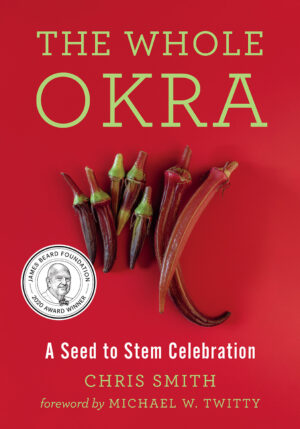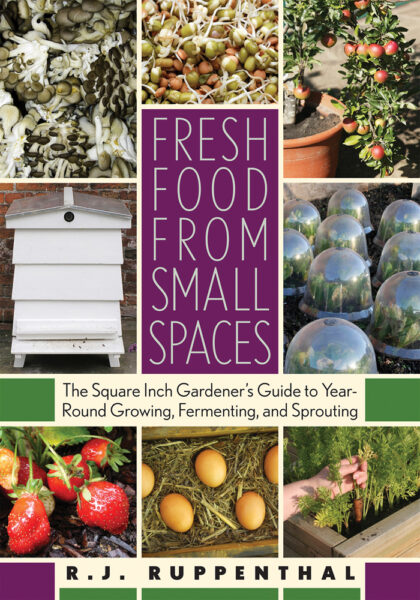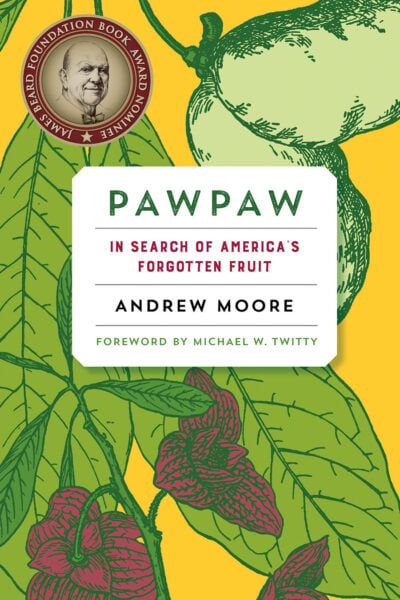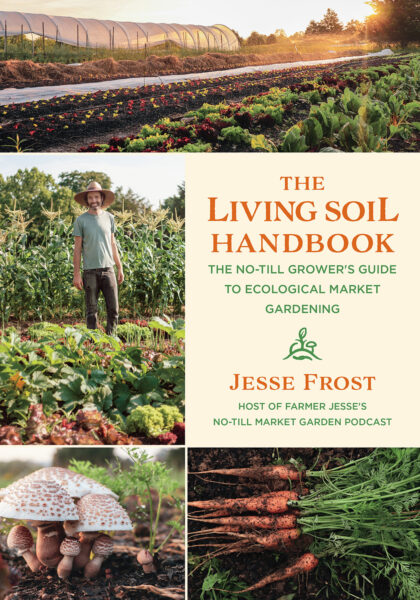How to Grow Okra Microgreens
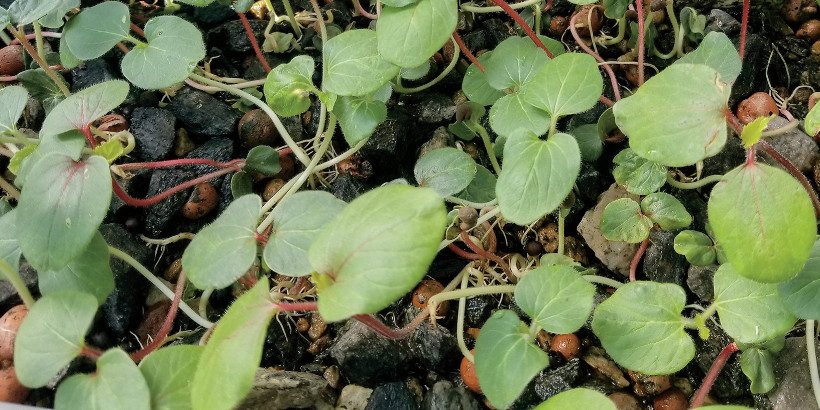
Microgreens can be used as a garnish or addition to provide great nutrients to your meals. Recently, okra joined the list of delicious microgreens. You can grow your own at home! Okra can be grown using an aquaponics system; find a use for any gallon-drums you have left in your garage or shed.
The following is an excerpt from The Whole Okra by Chris Smith. It has been adapted for the web.
Prefer audio?
Listen to the excerpt below from the audiobook of The Whole Okra.
Once I had a random bag of okra seeds simply labeled red okra that I anticipated would germinate poorly. I’d found it at the bottom of a box at the Sow True Seed storage facility, and no one remembered how it had come to be there. Okra seeds are not known for their longevity, and I’d been working at Sow True Seed for about four years at the time of discovery, so we assumed the okra was older than that. I’m never one to give up on a seed, though, so when I expect low germination, I compensate by planting a bunch more seeds than usual. Sod’s Law always wins: If you overplant, suspecting low germination, then they’ll all germinate.
If you plant old seeds at standard spacing, however, they’ll fail to germinate and you’ll have a patchy patch. The random red okra followed this law. Seedlings sprouted in dense clumps. I had to thin them out with scissors to reduce competition and allow the remaining seedlings enough space to keep growing. I ended up with a small basket full of very tender-looking, red-stemmed okra cotyledons (the first leaf stage before true leaves appear). I nibbled on a leaf; it had heft and that distinct nutty flavor you’ll begin to associate with raw okra.
I often overseed crops, knowing an early thinning can be eaten as microgreens, a later thinning as baby leaves, and a final mature-space thinning as braising greens (think beets, salad greens, brassicas, and turnips). In the case of okra, once beyond the cotyledon stage, the leaves lose that succulent nuttiness and take on more of their mallow family characteristics as well as “greener” flavor. The baby leaves are still a nice addition to a salad for diversity, but in general I prefer to cook the leaves unless they are really young.
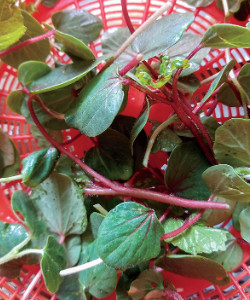
Thinning okra seedlings can quickly give you a basket full of okra microgreens.
I approached Sunburst Chef and Farmer, an Asheville microgreen and edible flower producer, suggesting that they give okra microgreens a go. I sometimes worry that my okra objectivity meter is off (or perhaps nonexistent), so I was keen to know how an experienced microgreen grower would assess okra microgreens. I gave Sunburst seeds of Clemson Spineless and Red Burgundy. Greenhouse manager Erica Blumenfield manages all the growing, and she gave me a tour of the Sunburst Chef and Farmer greenhouses.
I was amazed by the huge range of edible flowers and microgreens at various stages of production (they were already in their second season of growing okra flowers). Their production schedule was crazy because of the super-quick turnaround of microgreens.
Okra seeds germinate and grow best in warm soil, and luckily their greenhouses had a super-hot spot where they grew a lot of the heat-loving seeds. After their first round of experiments, Blumenfield sent me a message saying, “One member of staff didn’t care for them and one really liked them.” But the experiment piqued sufficient interest, and now you can order okra microgreens through Sunburst’s website. They are described as light green leaves with faint red stems, and a mild okra flavor.
Growing microgreens makes total sense if you are saving your own seeds, because seed saving produces a surplus. It’s one more spin-off benefit from a sustainable food system. You can trade some seed, sell some seed, eat some seed, regrow the seed, but also sprout some for super-tasty microgreens. I manage to do this all winter with a small aquaponics system that I set up in my hoop house. It’s super basic; in fact, I’m developing a DIY kit for a wheeled model that could live in your house!
I use a 55-gallon drum (these are often available cheaply or free on Craigslist). I chop off the top 8 inches (20 cm) of the drum. That top section gets flipped over and becomes the growing bed. It already has a screwhole in it, so all you need to do is find a plumbing attachment (PVC with a diameter of 2 inches / 5 cm) and fit a 6-inch (15 cm) length of standpipe.
The standpipe allows water to fill the growing bed to a depth of 6 inches and then drain through the pipe back into the water tank below. The rest of the growing bed is filled with gravel and clay pellets to a depth of 7 or 8 inches (17.5–20 cm). Protection over the standpipe hole is required to stop the stone and gravel falling down the hole.
I use a wider-diameter pipe with an endcap and lots of small holes drilled in (so water can pass through the pipe but the stones/clay can’t). A cheap pond pump and a length of rubber piping works well to pump water from the tank to the growing bed, and water from the growing bed will overflow back into the tank on a continuous cycle. I raise fish in the bottom of the growing bed (goldfish for mosquitoes and a few tilapia in summer), who provide fish-poop fertilizer, and I have red wiggler worms in the top, who help break down roots and organic matter into usable plant food.
I use the growing beds primarily for growing microgreens and baby greens. It’s crazy 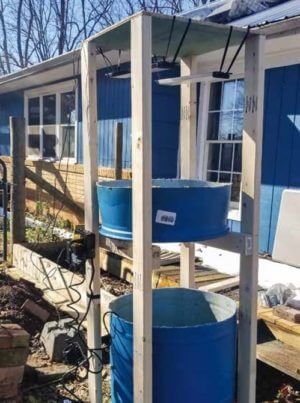 how productive and easy this closed-loop system is. (Well, it’s almost a closed loop; I feed the tilapia black soldier fly larvae that I raise as part of my composting system, but I give the tilapia a supplemental high-protein food as well.) Fish poop for fertilizer, plant roots for biofilters, and I get to eat greens and fish!
how productive and easy this closed-loop system is. (Well, it’s almost a closed loop; I feed the tilapia black soldier fly larvae that I raise as part of my composting system, but I give the tilapia a supplemental high-protein food as well.) Fish poop for fertilizer, plant roots for biofilters, and I get to eat greens and fish!
On the rare occasion that I buy a plastic box of salad, I am horrified by the wasteful packaging, by the probable runoff of fertilizers applied to the crops, by the water input required to grow crops in drought-ridden California, by the carbon-heavy food-miles that the salad spent in refrigerated trucks being transported to the East Coast, by the energy-wasting opensided supermarket coolers where those pretty plastic boxes are displayed, and by the speed with which the colorful leaves rot in my fridge.
Conversely, I can walk into my garden with a pair of scissors and harvest a salad that is diverse and delicious. If I educate myself, I can also eat half the weeds growing there—plants that require no energy or time for planting or maintenance. Harvesting seasonal garden greens and wild greens is one of the easiest ways to start re-localizing our food systems.
And okra leaves are a supergreen!
“I should get a cape,” says Okra.
Recommended Reads
Recent Articles
Garden strawberries are excellent for both covering the ground and for growing fruit. If you’re planning out a forest garden, or are just looking for a plant to use as ground cover, strawberries are a great option. The following is an excerpt from The Home-Scale Forest Garden by Dani Baker. It has been adapted for…
Read MoreChances are, you’ve seen cattails growing on the edge of your local lake or stream at least once or twice. Instead of just passing these plants, try foraging for and cooking them to create delicious seasonal dishes! The following excerpt is from The New Wildcrafted Cuisine by Pascal Baudar. It has been adapted for the…
Read MoreWith the right strategies and practices, composting on a small farm is surprisingly easy and inexpensive. Just follow these steps for making compost, and your farm will be thriving in no time! The following excerpt is from The Lean Farm Guide to Growing Vegetables by Ben Hartman. It has been adapted for the web. (All photographs by Ben…
Read MoreGarlic mustard: while known as “invasive,” this plant can be consumed in its entirety and has great nutritional value. Plus, the garlic-flavor is a perfect addition to any recipe that calls for mustard! The following are excerpts from Beyond the War on Invasive Species by Tao Orion and The Wild Wisdom of Weeds by Katrina…
Read MoreEveryone loves a refreshing, fermented, nutritious drink…even your garden! Take your fermentation skills out of the kitchen and into the garden by brewing fermented plant juice. The following is an excerpt from The Regenerative Grower’s Guide to Garden Amendments by Nigel Palmer. It has been adapted for the web. How to Make Fermented Plant Juice Fermented…
Read More

